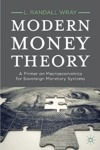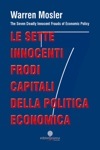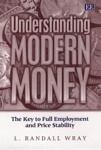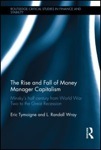Thanks for comments. Let me provide a dozen responses, by topic.
Q: What about interest on reserves?
A: Chairman Bernanke moved to pay interest on reserves a couple of years ago, joining other countries (like Canada) that do so. Does that make any difference? Yes and no. First it simplifies operations and renders Treasury bond sales superfluous. Since the purpose of bond sales is to provide an interest-earning alternative to non-interest paying reserves, once you pay interest on reserves that is effectively the same thing as a bond. Ergo, you can stop selling bonds.
Now, why do you sell bonds when reserves don’t pay interest? Because excess reserves in the system drive overnight rates below the central bank’s target. It then sells bonds to offer the alternative.
But the easiest way to hit a target interest rate is to charge—say—50 basis points (100 bp = one percentage point) on loans at the discount window then to pay 25 bp on reserves held at the central bank. The overnight market rate on interbank lending (fed funds in the US) cannot deviate from the 25 to 50 bp range. (These are the ceilings and floors—you can do the same thing with sheep wool: government pays $25 to buy wool and sells at $50 so wool never rises above $50 nor falls below $25). The narrower that range, the smaller the flux of overnight rates.
Now as we know the US (and Canada) still sells bonds. This mostly has to do with the maturity structure: reserves are close substitutes for very short term bonds (ie: 30 day bills), and the central bank normally stays at the very short end.
Not that Treasuries understand any of this: when rates on 30 year maturity bonds are low, they issue lots of those thinking they’ll save on interest payments. But any Central bank with a floating rate can set the overnight rate anywhere it wants, and then just pay interest on reserves—no need to ever issue long maturity debt. Call your Treasury official and explain this. Stop issuing bonds = never run up against debt limits = never have kindergarten level debates in congress about debt limits.
Q2: In real terms, do government deficits take away “real saving”?
A: At full employment, government deficits move resources away from other uses to the public purpose. That might be good; it might be bad. With fewer resources available for private use, private investment might be lower. In that sense, “private real saving” is less. Fewer shopping malls, more schools and museums. Less investment in producing social life-altering underarm sprays, and more investment in bridges that do not collapse into rivers. I don’t know which to choose. But I’ve been flying a lot, avoiding bridges but sitting next to passengers who could use the spray.
Judge that for yourself. In nominal terms, however, government deficits create equivalent private savings—dollar for dollar. (Full disclosure, some can leak out to imports from Mars, etc.)
Q3: How does the central bank (CB) affect interest rates? Using open market operations (OMO)? Does it use the fed funds rate or discount rate? Is the 10 year bond rate set by the CB or by the market?
A: From above, we know CBs target overnight interest rates, and can use the ceilings and floors approach: lend at the discount window at 50bp and pay 25bp on reserve balances. In which case the “market rate” will flux between the two. Is this done through OMO? Not really. If the CB announces it will move its target rate from the range of 25-50bp to 50-75bp it does not need to engage in any OMO. All it does is to increase its rate paid on reserves to 50, and increase its discount rate charged to 75. And then “presto-change-o” market rates move. So you can see it uses both the fed funds rate (target) and the discount rate (rate charged), as well as the “support rate” paid on reserves.
What about longer maturities like the 10 year? It could do the same in that maturity—offer to buy at an interest rate equivalent of 200 bp and to sell at 150bp and you can bet your bottom dollar that the 10 year will trade in that range. But normally central banks do not do that. (QE tried a backassward way to do it: using quantity rather than price to try to get long rates down. Didn’t work—but who says Bernanke knows what he’s doing?)
Q4: What is endogenous vs exogenous?
A: It is somewhat arbitrary; and these terms are used in different senses (for the truly wonky: statistical, theoretical, or control senses). To keep it simple, most people use these to refer to the policy sense: does the government control the variable? For example, does the CB control the “money supply” or the “interest rate”. Well, it clearly cannot control the money supply—however measured except in the sense that it can do a Bernanke and fill banks full of excess reserves (that cannot get out). But it clearly can set overnight interest rates—all of them do—so that is called “exogenous” control of interest rates.
Q5: If the deficit gets bigger and bigger, doesn’t it have to get repaid later out of savings?
A: No. The US government debt was only “repaid” once in our nation’s history: 1837. That will never happen again. Bet on it.
Q6: In a fixed exchange rate system does govt really “choose” to spend less (or raise its interest rate target) to protect currency?
A: Yes. In the sense that it can “choose” not to do so, and then deal with the consequences. You can “choose” not to drive on the right (or left) side of the road. You might not enjoy the outcome. I’ve done it. You probably have, too. You might even “choose” to drive above the speed limit, too. There are consequences, and we all deal with them.
Q7: Does it matter if govt spends money into existence for interest payments rather than wages (as in ELR program)?
A: Yes. It can also spend money into existence to support fat cat Wall Street fraudsters. Good idea? Maybe not. Will it run out of funds? No.
Q8: Use GDP income measure rather than GDP expenditure measure.
A: Well, by identity they are identical. But, yes, it does matter that the wage share in the US has dropped toward third world status (about 50% of national income; vs 25% in Mexico). And so for consumption to grow Americans had to borrow heavily. Bad idea.
Q9: MMT has an unwarranted fixation on nominal vs real.
A: Give me a break, Neil. I guess you slept all through last week (see Blog 17). If anyone suffers from a fixation it is our Austrian brethren who are so fixated on “real” that they cannot understand that we live in a monetary economy.
Thanks, Eric and Calgacus.
Q10: Can the CB compel banks to support higher reserve levels; can the CB control interest rates without issuing reserves?
A: CB can raise required reserve ratios, and banks (magically!) will hold more! That acts like a tax on banks, increasing their cost of doing business as reserves pay very little, ie 25 bp. Banks are less profitable. Not sure why we want that. In the Canadian system, bank holdings are right about zero—since the Bank of Canada requires zero and operates with a ceiling and floor interest rate as described above. Nice system. Sometimes those Canadians surprise you with how clever they can be! So, yes, they hit their interest rate targets even as banks essentially hold no reserves. But they do use them for clearing—which is all that matters.
Q11: How are government bonds issued?
A: By Treasury, to special banks, that use reserves to buy them. The CB supplies the reserves the banks need. We’ll do more of this later.
Q12: I go to a bank and it creates a loan; does it create money out of thin air? Is this disreputable?
A: Yes. And No. It takes your IOU, and creates its own IOU (your demand deposit). Out of a keystroke to a computer tape. Sounds a bit sexy but not at all pornographic. It is the bank’s IOU. It gets your IOU (“loan”) and goes into debt (demand deposit). It does not “get something for nothing”. If it eventually earns profits on the deal, that is a reward for “underwriting”: determining that you are no scumbag deadbeat borrower who will default.
I think that’s the nicest thing I’ve ever said about a banker. Made her sound almost like Jimmy Stewart. On that note I should stop.














